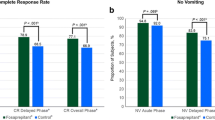Abstract
Selective antagonists to the Type 3 serotonin receptor (5HT3) in combination with corticosteroids are now considered the standard of care for the prevention of emesis from moderately to highly emetogenic chemotherapy. Here we address issues of optimal dose, schedule and route of administration of four currently available selectable 5HT3 antagonists. This paper utilizes an evidence based medicine approach to the literature regarding this class of drugs, emphasizing the results large, randomized, controlled trials to make formal recommendations concerning optimal use of this important new class of anti-emetic agents. We conclude that for each drug there is a plateau in therapeutic efficacy at a definable dose level above which further dose escalation does not improve outcome. Furthermore, a single dose is as effective as multiple doses or continuous infusion, and finally, emerging data demonstrate that the oral route is equally efficacious as the intravenous route of administration, even with highly emetogenic chemotherapy.
Similar content being viewed by others
Author information
Authors and Affiliations
Rights and permissions
About this article
Cite this article
Gandara, D., Roila, F., Warr, D. et al. Consensus proposal for 5HT3 antagonists in the prevention of acute emesis related to highly emetogenic chemotherapy . Support Care Cancer 6, 237–243 (1998). https://doi.org/10.1007/s005200050160
Issue Date:
DOI: https://doi.org/10.1007/s005200050160



